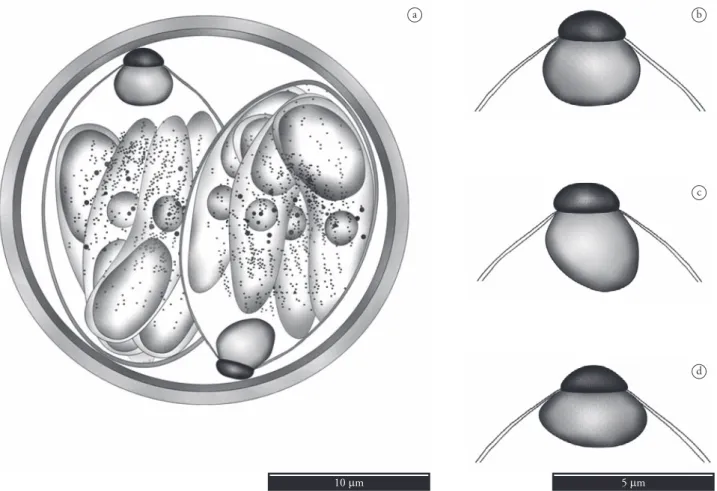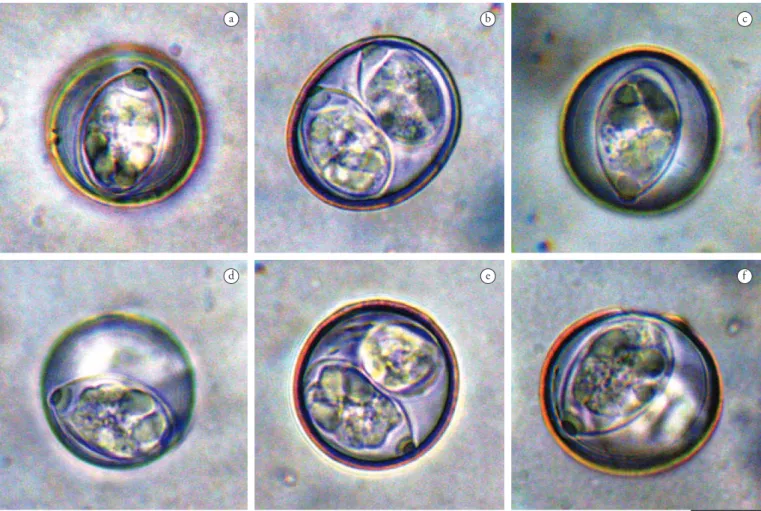www.cbpv.com.br/rbpv
Isospora coerebae
n. sp. (Apicomplexa: Eimeriidae) from the
bananaquit
Coereba flaveola
(Passeriformes: Coerebidae)
in South America
Isospora coerebae n. sp. do caga-sebo Coereba flaveola (Passeriformes: Coerebidae) na América do Sul
Bruno Pereira Berto1; Walter Flausino1; Hermes Ribeiro Luz2; Ildemar Ferreira2; Carlos Wilson Gomes Lopes1*
1Departamento de Parasitologia Animal, Instituto de Veterinária, Universidade Federal Rural do Rio de Janeiro – UFRRJ
2Departamento de Biologia Animal, Instituto de Biologia, Universidade Federal Rural do Rio de Janeiro – UFRRJ
Received June 29, 2010 Accepted December 9, 2010
Abstract
The present study describes a new isosporoid coccidian parasite from the bananaquit Coereba flaveola, in Brazil. This new species is similar to I. cagasebi, but it can be distinguished by the size and shape of Stieda and susbstieda bodies.
Isospora coerebae n. sp. oocysts are spheroidal to sub-spheroidal, 24.8 × 23.3 µm, with a smooth and bi-layered wall, ~1.2 µm. Micropyle, oocyst residuum and polar granule are absent. Sporocysts are elongate ovoidal, 17.9 × 10.9 µm. Stieda and substieda bodies are present. Sporocyst residuum is present and sporozoites have a posterior refractile body.
Keywords:Passeriformes, Coerebidae, oocysts, Marambaia Island, Brazil.
Resumo
Um novo parasito coccídio isosporóide do caga-sebo Coereba flaveola, do Brasil, é relatado no estudo atual. Essa nova espécie é semelhante à Isospora cagasebi, no entanto, pode ser distinguida pelos tamanho e forma dos corpos de Stieda e substieda. Os oocistos de I. coerebae n. sp. são esféricos a subesféricos, 24,8 × 23,3 µm, com parede dupla e lisa, ~ 1,2 µm. A micrópila, resíduo e grânulo polar do oocisto estão ausentes. Os esporocistos são ovóides alongados, 17,9 × 10,9 µm. Os corpos de Stieda e substieda estão presentes. O resíduo do esporocisto está presente e os esporozoítos possuem um corpo refrátil posterior.
Palavras-chave: Passeriformes, Coerebidae, oocistos, Ilha da Marambaia, Brasil.
*Corresponding author: Carlos Wilson Gomes Lopes Departamento de Parasitologia Animal, Instituto de Veterinária, Universidade Federal Rural do Rio de Janeiro – UFRRJ, BR-465, Km 7, CEP 23890-000, Seropédica - RJ, Brazil; e-mail: lopescwg@ufrrj.br
Introduction
The bananaquit Coereba flaveola Linnaeus, 1758 is a small honeycreeper in the family Coerebidae. It is common in and around gardens where flowers are abundant. It adapts well to human activity, and lives in borders of open country, plantations, towns and forests (SICK, 1997; RAFFAELE et al., 1998).
Coccidiosis in this host family is rare with only a single species,
Isospora cagasebi Berto, Flausino, Luz, Ferreira, Lopes, 2008, described by Berto et al. (2008) infecting a bananaquit of Brazil.
It is here described a new Isospora species named Isospora coerebae and also I. cagasebi infecting the bananaquit C. flaveola
from Marambaia Island, Rio de Janeiro State, Brazil and the characteristics of Stieda and substieda bodies that differentiate these two coccidia.
Material and Methods
drawings were prepared using a binocular microscope Wild M-20 with drawing tube. Pictures were taken using a digital camera (Model CD Mavica MVC-CD250 Sony®). Size ranges are shown in parenthesis followed by average and shape index (L/W ratio). Means comparisons of Stieda and substieda bodies by Student’s
t-test were performed using Excel XP (Microsoft Co., Redmond, WA, USA), as proposed by Sampaio (2002).
Results
Th ree of eight C. fl aveola examined shed oocysts in their feces. All oocysts were typical for the genus Isospora. Two types of oocysts were recorded, each type was detected in two birds, and the third bird presented a mixed infection. Th e fi rst type of oocysts was identifi ed as Isospora cagasebi. Th e second type of oocysts could
be well recognized from I. cagasebi and seemed to represent an unknown species, the description of which follows.
Isospora cagasebi Berto, Flausino, Luz, Ferreira, Lopes, 2008 (Figures 1a-d, 3a-c)
Description of a sporulated oocyst: Oocyst shape (N = 11): spheroidal to sub-spheroidal; number of walls: 2; wall thickness: 1.3 (1.1–1.3); smooth outer wall about 2/3 of total thickness; L × W: 25.2 × 24.5 (23-27 × 23-25), with L/W ratio: 1.0 (1.0-1.1); M, OR, PG: all absent.
Description of a sporocyst and sporozoites: Sporocyst shape (N = 11): elongate ovoidal or ellipsoidal; L × W: 18.7 × 11.4 (17-20 × 10-12); L/W ratio: 1.6 (1.5-1.7); SB: present and knob-like; SSB: present and prominent (Table 1); PSB: absent; SR: present; SR characteristics: composed of many scattered granules of diff erent sizes; SZ: vermiform with SRB and N.
Host: Coereba fl aveola Linnaeus, 1758 (Passeriformes: Coerebidae), captured on January 13, 2009.
Materials: Oocysts stored in 10% aqueous buff ered forma-lin (v/v), and deposited in the Parasitology Collection at the Department of Animal Parasitology at UFRRJ, Seropédica, Rio de Janeiro, Brazil. Phototypes and line drawings are depo-sited at the same location. Th e repository number is 07/2009.
Locality: Marambaia Island (23° 04’ S and 43° 53’ W), Rio de Janeiro, Brazil.
Sporulation time: Four days.
Site of infection: Not investigated.
Prevalence: 25% (two of eight birds examined).
Isospora coerebae n. sp. (Figures 2a-d, 3d-f )
Description of a sporulated oocyst: Oocyst shape (N = 14): spheroidal to sub-spheroidal; number of walls: 2; wall thickness: 1.2 (1.1–1.3); smooth outer wall about 2/3 of total thickness; L × W: 24.7 × 23.3 (23-27 × 21-26), with L/W ratio: 1.1 (1.0-1.1); M, OR, PG: all absent.
a b
c
d
Table 1. Means comparisons of Stieda and substieda bodies of Isospora cagasebi and I. coerebae n. sp. recovered from bananaquit Coereba fl aveola.
Means Oocyst samples (µm)
I. coerebae(n = 11) I. cagasebi (n = 11)
Oocyst Shape spheroidal to sub-spheroidal spheroidal to sub-spheroidal
Length 24.7 (23-27)a 25.2 (23-27)a
Width 23.3 (21-26)a 24.5 (23-25)a
Shape index 1.1 (1.0-1.1)a 1.0 (1.0-1.1)b
Wall bi-layered, ~1.2 bi-layered, ~1.3
Polar granule absent absent
Sporocyst Shape elongate ovoidal elongate ovoidal or ellipsoidal
Length 17.7 (16-19)a 18.7 (17-20)b
Width 10.9 (10-12)a 11.4 (10-12)a
Shape index 1.6 (1.5-1.8)a 1.6 (1.5-1.7)a
Stieda body Shape prominent and rounded knob-like
High 1.2 (0.9-1.4)a 0.9 (0.7-1.2)b
Wide 1.9 (1.7-2.1)a 2.0 (1.9-2.1)b
Substieda body Shape short and widely prominent
High 1.2 (0.9-1.3)a 2.3 (2.0-2.6)b
Wide 4.0 (3.6-4.5)a 2.9 (2.6-3.3)b
Residuum diff use diff use
aDiff erent letters in each line denote statistically signifi cant diff erences (p < 0.01) by the Student’s t-test.
a b
c
d
a b c
d e f
Figure 3. Photographs of sporulated oocysts of coccidia species recovered from the bananaquit Coereba fl aveola. (a, b, c) Isospora cagasebi and (d, e, f) I. coerebae. Scale bar: 10 µm.
Description of a sporocyst and sporozoites: Sporocyst shape (N = 14): elongate ovoidal; L × W: 17.7 × 10.9 (16-19 × 10-12); L/W ratio: 1.6 (1.5-1.8); SB: present, prominent and rounded; SSB: present, short, however wi-dely ( Table 1); PSB: absent; SR: present; SR characteristics: composed of many scattered granules of different sizes; SZ: vermiform with a posterior SRB.
Type host:Coereba fl aveola Linnaeus, 1758 (Passeriformes: Coerebidae), captured on January 13, 2009.
Type material: Oocysts stored in 10% aqueous buff ered
formalin (v/v), and deposited in the Parasitology Collec-tion at the Department of Animal Parasitology at UFRRJ, Seropédica, Rio de Janeiro, Brazil. Phototypes and line drawings are deposited at the same location. Th e repository number is P-32/2009.
Type locality: Marambaia Island (23° 04’ S and 43° 53’ W), Rio de Janeiro, Brazil.
Sporulation time: Four days.
Site of infection: Not investigated.
Prevalence: 25% (two of eight birds examined).
Etymology: Th e specifi c epithet is derived from the generic name of the host type.
Comments: Th e I. coerebae oocysts can be basically distin-guished by the shape of SB and SSB. Isospora cagasebi oocysts present knob-like SB and prominent SSB, while I. coerebae
has rounded, short and widely SB and SSB.
Discussion
Th e new species described in this present study is close to
I. cagasebi. At 400x magnifi cation it is not possible to distinguish oocysts of the two species, however, at 1000× magnifi cation two distinct types of SB and SSB are visualized. Th us, the I. cagasebi
oocyst was redrawn, with details of SB and SSB, for comparison with the new species I. coerebae. Means comparisons of Stieda and substieda bodies between these species confi rmed that each species can be distinguished morphologically and morphometrically, as signifi cant diff erences among all analyzed parameters were found (Table 1).
and substieda complex. According to Duszynski and Wilber (1997), new coccidian species should be compared in detail with coccidian species that are feature-similar and belong to the same host family. Due to the lack of descriptions of coccidia in Coerebidae family, I. coerebae was only compared with I. cagasebi.
The Coerebidae family is grouped into a single species,
C. flaveola; however it can be approached to the Thraupidae and Emberezidae families (BURNS; HACKETT; KLEIN, 2003; CBRO, 2009). Thus, Berto et al. (2008) compared I. cagasebi
with coccidian species parasites of these two families. These comparisons are equally valid to I. coerebae. Up to date the coccidia support the classification of C. flaveola in an exclusive
family since coccidia of coerebids have not yet been reported in thraupids and emberezids.
Acknowledgements
We thank the Brazilian Navy, especially CADIM (Centro de Adestramento da Ilha da Marambaia) commander who authorized our access to Marambaia Island and the use of some CADIM facilities during the fieldwork.
References
BERTO, B. P. et al. Isospora cagasebi sp. nov. (Apicomplexa, Eimeriidae) from the bananaquit, Coereba flaveola of Brazil. Acta Parasitologica, v. 53, n. 2, p. 117-119, 2008.
BURNS, K. J.; HACKETT, S. J.; KLEIN, N. K. Phylogenetic relationships of Neotropical honeycreepers and the evolution of feeding morphology. Journal of Avian Biology, v. 34, n. 4, p. 360-370, 2003.
COMITÊ BRASILEIRO DE REGISTROS ORNITOLÓGICOS - CBRO. Lista das Aves do Brasil. Rio de Janeiro: CBRO, 2009. 38 p.
DUSZYNSKI, D. W.; WILBER, P. G. A guideline for the preparation of species descriptions in the Eimeridae. Journal of Parasitology, v. 83, n. 2, p. 333-336, 1997.
GRULET, O.; LANDAU, I.; BACCAM, D. Les Isospora du Moineau domestique; multiplicite des especes. Annales de Parasitologie humaine et Compareè, v. 57, n. 3, p. 209-233, 1982.
RAFFAELE, H. et al. A Guide to the Birds of the West Indies. Princeton: Princeton University Press, 1998. 500 p.
SAMPAIO, I. B. M. Estatística aplicada à experimentação animal. 2. ed. Belo Horizonte: FEPMVZ, 2002. 265 p.


